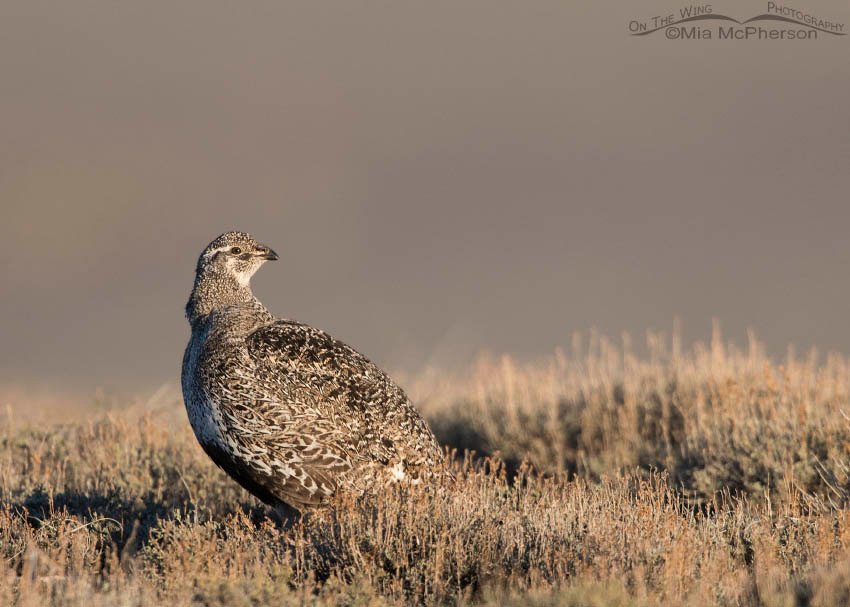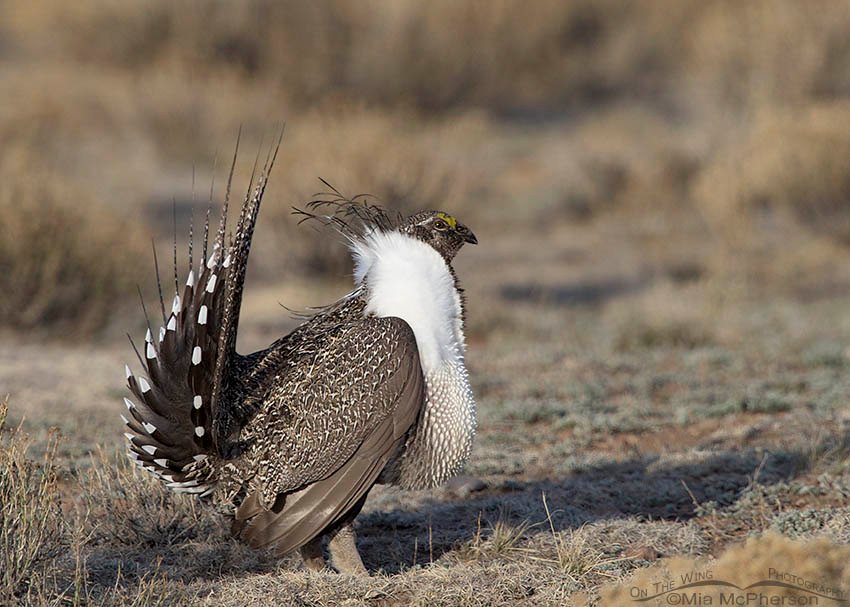 Female Greater Sage-Grouse at sunrise – Nikon D810, f6.3, 1/640, ISO 400, Nikkor 500mm VR with 1.4x TC, natural light
Female Greater Sage-Grouse at sunrise – Nikon D810, f6.3, 1/640, ISO 400, Nikkor 500mm VR with 1.4x TC, natural light
Since the snow has started to fall in the high country of Utah I have started thinking about Greater Sage-Grouse again. Part of thinking about them is because I think of how hard they have to work to survive the harsh winters and the other part is because of the human-caused dangers they are facing that threaten their survival.
Oil exploration, wells, tar sands and the roads that cut through the sagebrush steppe are all problems for these Greater Sage-Grouse. If some Utah politicians had their way much of the wild land in this state would be sold or leased for oil & gas exploration and production regardless of what the people want and what our future needs. For what? Money, greed and the opportunity to make the pockets of the rich even fatter.
 Male Greater Sage-Grouse on a lek in Utah – Nikon D810, f6.3, 1/1250, ISO 640, Nikkor 500mm VR with 1.4x TC, natural light
Male Greater Sage-Grouse on a lek in Utah – Nikon D810, f6.3, 1/1250, ISO 640, Nikkor 500mm VR with 1.4x TC, natural light
But that means taking away public lands from the citizens of this country. Putting up fences, loud machinery and roads that dissect the sagebrush steppe where trucks rumble by 24 hours a day. And it isn’t just the grouse that are under pressure… it is all of the birds and animals that call the sagebrush sea home.
 Sparring male Greater Sage-Grouse – Nikon D810, f6.3, 1/1600, ISO 640, Nikkor 500mm VR with 1.4x TC, natural light
Sparring male Greater Sage-Grouse – Nikon D810, f6.3, 1/1600, ISO 640, Nikkor 500mm VR with 1.4x TC, natural light
During the winter the Greater Sage Grouse struggle to survive in deep snow by feeding on the exposed sagebrush. In the spring, those who survive will dance, display, spar and mate to continue the existence of their species.
I watched a movie earlier this year produced by PBS called The Sagebrush Sea and I highly recommend viewing it if you haven’t already. (As I write this PBS is having web site issues, please check back later to view it). The photography and videography by Gerrit Vyn is outstanding.
I’m in the sagebrush steppe quite often here in Utah to photograph the birds, wildlife and scenery I see and love there. It is critically important for all of us to protect and preserve it for future generations of birds, animals and people.
Life is good.
Mia
More of my Greater Sage-Grouse images


Beautiful! Lucky you to have them in your area!
Great images and info too. And thanks for the reminder to watch The Sagebrush Sea.
Your PBS link is working now — wonderful program!
Such a beautiful bird. Such a beautiful threatened bird.
Hiss and spit. And sigh.
Sage Spirit, a recently published book by Dave Showalter, explores the subject of our vanishing sage steppe.
I am fortunately not an American. I am Canadian and became so fed up with what the previous Canada’s Government Did in nine years, Centred on a guy and party who lived and breathed “Dig up the country an sell it” so we can keep these cushy jobs in government and retire on a huge pension with free health care and I would not WANT to know what other benefits . So after 9 years I gave up fighting it and moved to the Philippines where corruption is an accepted part and way of life.
I do not know how to cure their problems but I do know how to cure a lot of the USA problems . Every morning all the House of Reps and Senate shall sit and look at Mia’s post for the day for a minimum of 10 minutes It would be much more effective than Prayers Keep it up Mia if I was religious and still a Pope I would Canonicalize you.
Well, as part of the choir, I am smiling and I agree with both Patty and Michael although Michael, not all Americans are bad. We can each individually help spread the word and do our part. I, for one, do not drive much. My choice. We have a pond so yes, it uses water but secondary mostly and it does my heart good to see all the wildlife attracted to it, to bathe, to drink, to play and argue—waxwings and robins are quite amusing. My husband and I do not get out much anymore because he has Parkinson’s and he has lost the desire to see the world and yet, his black and white thinking that goes along with Parkinson’s has never made him much of an adventurer. Sorry to get off topic but I agree with Michael that if world leaders could sit and contemplate Mia’s photographs each morning, or better yet, accompany her, maybe they might have a different perspective and yet they can still only do so much. Lobbyists speak for them nowadays and we all consume in one way or another. We are all to blame because of our modern lifestyles but it’s all we’ve known and I do not see mankind going back to pre-“civilized” days. Life is a gift so we must see each day as such and hope that one day, we as a whole will help the earth more than we harm her. Thank you again Mia. Your photos always lift my spirit.
We can each individually help spread the word and do our part. I, for one, do not drive much. My choice. We have a pond so yes, it uses water but secondary mostly and it does my heart good to see all the wildlife attracted to it, to bathe, to drink, to play and argue—waxwings and robins are quite amusing. My husband and I do not get out much anymore because he has Parkinson’s and he has lost the desire to see the world and yet, his black and white thinking that goes along with Parkinson’s has never made him much of an adventurer. Sorry to get off topic but I agree with Michael that if world leaders could sit and contemplate Mia’s photographs each morning, or better yet, accompany her, maybe they might have a different perspective and yet they can still only do so much. Lobbyists speak for them nowadays and we all consume in one way or another. We are all to blame because of our modern lifestyles but it’s all we’ve known and I do not see mankind going back to pre-“civilized” days. Life is a gift so we must see each day as such and hope that one day, we as a whole will help the earth more than we harm her. Thank you again Mia. Your photos always lift my spirit.
I agree with Cindy, but worry, a LOT, that you’re “preaching to the choir”…most of your and Ron’s followers feel the same way you do already. It’s up to all of us to spread the word the best we can and as far as we can…but, I’m afraid “the word” too often falls on deaf ears…and, worse, numb minds…..
Absolutely beautiful photos, Mia. Growing up in the Texas Panhandle, we had a similar bird called the Prairie Chicken. Amazing birds.
The show you write of, Mia was on the other night. Unfortunately your observations are all correct. I live in Utah and understand how the environment is seen by the politicians, etc. The earth can only be exploited for so long–she is already responding to what we’ve done to her. Mankind does not learn easily it seems so it’s up to people like you to continue to sound the alarm and hopefully the photos you take are not of extinct species in the future. Exquisite birds, lighting and talent. Thank you, Mia.